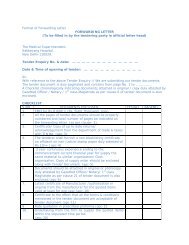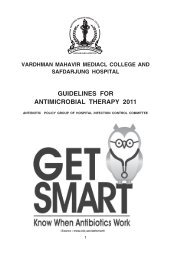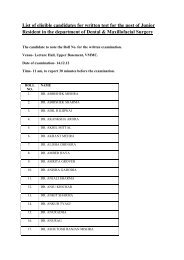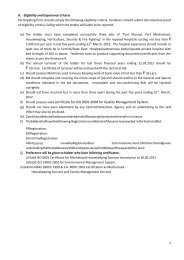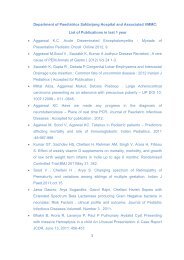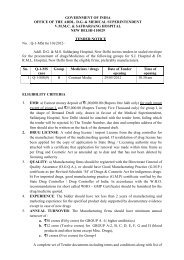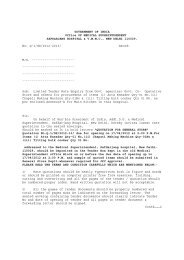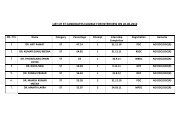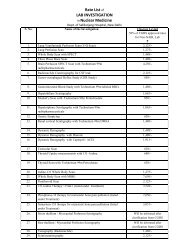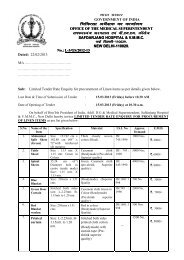Guidelines for INFECTION CONTROL POLICY - Safdarjung Hospital
Guidelines for INFECTION CONTROL POLICY - Safdarjung Hospital
Guidelines for INFECTION CONTROL POLICY - Safdarjung Hospital
Create successful ePaper yourself
Turn your PDF publications into a flip-book with our unique Google optimized e-Paper software.
To ensure the disinfection/pretreatment of the waste without at the site of generation, thefollowing guidelines/advisory is followed in all areas:-1. Use of needle destroyer the needles and then the same is put into the puncture proofcontainer containing hypochlorite solution.2. After use, the nozzle of Syringes is to be cut with the needle destroyer. Draw some bleachsolution into the syringe or separate the piston and barrel, and place it in the containerwith a sieve having 1% hypochlorite solution <strong>for</strong> 30 minutes. After 30 minutes the syringeare placed in the blue bags by lifting the inner sieve.3. In the gloves are clipped immediately after use by the dedicated pair of scissors placedin the area to prevent reuse and the dipped in 1% hypochlorite solution in a bucket <strong>for</strong>30 minutes <strong>for</strong> disinfection. After disinfection they should be placed in a blue bag.4. All plastic items IV bottles, urobags, brains etc. are given a nick putting in blue bag. Eachbag is labeled and securely tied when three-fourths full.COLLECTION STORAGE, LABELING, AND RECORDING OF WASTEAll the biomedical waste is labeled as waste type, site of generation, date of generation be<strong>for</strong>etransportation from the generation site. Waste is stored in the areas of generation at an identifiedsafe area, <strong>for</strong> an interim period after which it is transported <strong>for</strong> onsite treatment and finaldisposal. During this period it is the responsibility of the waste. No untreated bio-medical wasteshall be kept stored beyond a period of 48 hours.Collection si done- Daily from all areas- Done twice daily or more frequently <strong>for</strong>m labor rooms/ OTs- Label is filled up by staff on duty and given to waste collectorsEach patient care area has been provided with the waste receipt book to record the quantity/number of yellow and blue gabs handed over the HCW. All the staff are required to duly fullin the waste book color wise mentioning the number and size of bags handed over and signthe slip <strong>for</strong> further record.TRANSPORTATION :<strong>Hospital</strong> waste is transported in securely tied bags from the site of generation to the treatmentfacility (incinerator premises) through designated route, on dedicated, color coded, covered andleak proof wheel barrows/Trolleys. At the waste treatment premises verification of the number/size of the bags is done <strong>for</strong> each trolley by the sanitation staff <strong>for</strong> recording and quantificationbe<strong>for</strong>e disposal.Chemical disinfection of the trolleys using hypochlorite solution is being at the waste storagesite.3. TREATMENT FACILITIES :EQUIPMENT :<strong>Safdarjung</strong> hospital has the following Equipment <strong>for</strong> in-house treatment of waste:1. Incinerator : 3 units of incinerator were installed in 1994 having chimney height of30 meters each, capacity 150-175 kg/hr. Only one is equipped with APCD and is inuse.2. Microwave : Microwave with a capacity of 60 Litres per cycle is available at the wastesite. All the infectious plastic waste is disinfected in Microwave.3. Shredder Machine : One indigenous type and one ‘Bometic’ shredder machine isinstalled in 1998. It is used to shred plastic and PVC materials such as I.V. bottles,disposable syringes, IV tubing etc. after they have been micro waved at the site ofgeneration24



